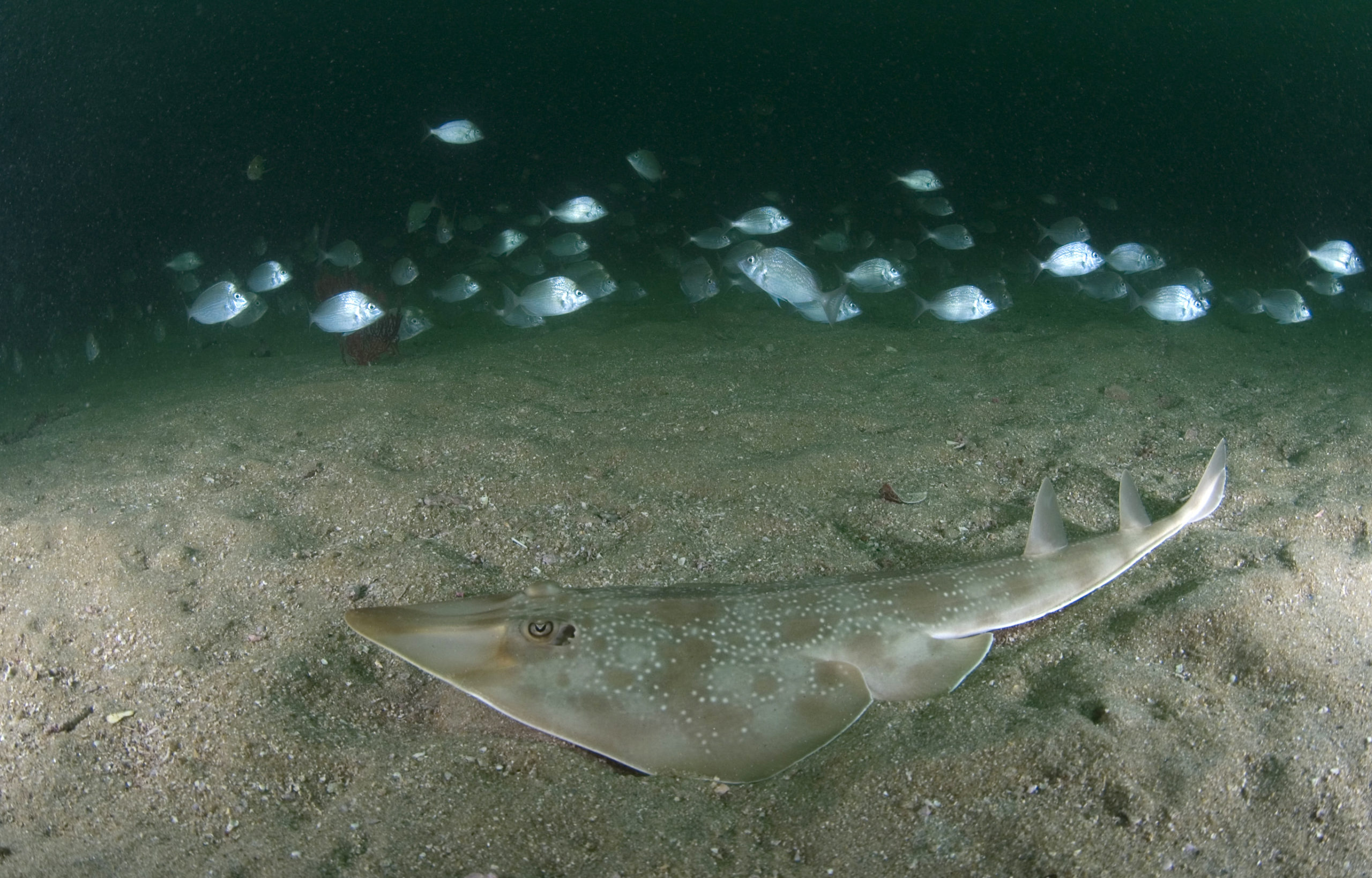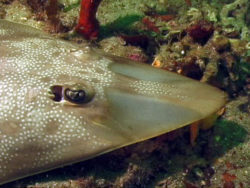
Sea Wonder: Guitarfish

A guitarfish resting on the bottom of Gray’s Reef National Marine Sanctuary. Photo: Greg McFall
A guitarfish doesn’t have strings – and even if it did, it would likely sound a little flat. These flat-bodied cartilaginous fishes represent a family of at least 50 different species, including the Atlantic guitarfish, bowmouth guitarfish, and shovelnose guitarfish to name a few. The genus’ scientific name, Rhinobatis, is a combination of Greek and Latin words for shark and ray. This is because they are flat like rays but look and swim with their tails like sharks.
Description
Guitarfish are characterized by elongated bodies with flattened heads, pointy snouts, and wing-like fins on each side of their bodies. These fishes are named for the guitar-like shape of their bodies. They can reach lengths of nearly six feet and weigh more than 40 pounds on average, though this varies greatly based on species, habitat, and individual genetics. Their skin is a mottled olive or sandy brown color to help them blend into their environments. Their eyes sit atop their heads while their mouths are located on a disc on their underside. They breathe using organs called spiracles on their heads, which allows them to remain perfectly still beneath the sand.
Diet & Habitat

Guitarfish are bottom feeders that live on a diet of fish and invertebrates like crabs, shrimp, worms, and clams. They are more active at night because hunting is more successful, but they can feed any time of day. To forage, they either cruise above the sandy seafloor and use their fins to stir up sediment and reveal potential prey, or they hide beneath the sandy seafloor with only their eyes visible, waiting for an unsuspecting victim to pass by before the guitarfish ambush it. They catch, crush, and swallow whole their prey using their strong jaws. Larger sharks and California sea lions are known predators of guitarfish.
Guitarfish prefer shallower habitats and are found in tropical, subtropical, and warm temperate waters worldwide, depending on the species. Similarly, you can find them throughout the National Marine Sanctuary System like in Gray’s Reef and Flower Garden Banks national marine sanctuaries. They usually live in shallow, coastal waters and prefer sandy seafloors, which is where they spend most of their time when they are not foraging. They live in and near bays, estuaries, and seagrass beds, which are all full of great places to hide and have abundant food.
Life History
Like other species of sharks and rays, guitarfish reproduce using internal fertilization strategies. Females incubate embryos internally, providing them nutrition through yolk sacs, allowing the pups to grow through several life stages before they are born. Reproduction seasons and behaviors varies by species, habitat, and environmental conditions, but pups are born live and well-developed, which can increase the likelihood that they will survive into adulthood. A guitarfish pregnancy can last as long as a year and result in between two and 12 pups at a time. In the northern hemisphere, Atlantic guitarfish will give birth between August and November each year. Depending on the species, guitarfish can live as long as 15 years, but the average is between eight and 10 years.
Guitarfish are not highly social but do often live near and occasionally interact with other individuals. They swim like sharks, moving their long tails side to side, which leads people to often mistake these animals for sharks. If the animals need to accelerate or steer themselves, they use their pectoral fins much like a ray would. These animals are unique in that they don’t swim completely horizontally, but instead, swim with their head angled slightly above the rest of their body, which is called a positive swimming angle.
Threats & Conservation
Guitarfish were historically thrown out from commercial fishing catches when they were caught by accident, but in more recent years are more desirable and are part of a minor fishery. These animals help supply the shark fin trade in many countries outside of the United States and are an important part of subsistence fishing in smaller island and coastal communities. In 2018, NOAA’s National Marine Fisheries Service listed several guitarfish species as threatened or endangered under the United States’ Endangered Species Act. The International Union for Conservation of Nature (IUCN) Red List classifies many species in the guitarfish family as vulnerable, threatened, or even critically endangered. Threats to the species include fishing, habitat loss, prey availability, coastal development, and climate change and ocean acidification.

An atlantic guitarfish ( Rhinobatus lentiginosus ) seen in the Gulf of Mexico. Photo credit: SEFSC Pascagoula Laboratory; Collection of Brandi Noble, NOAA/NMFS/SEFSC
